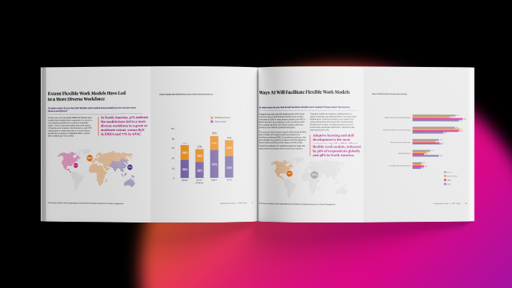The way we work is changing. Employers are engaging more contingent workers, AI is at the forefront, and work-life balance is becoming a focus.
Flexibility at work is now essential for both employees and organizations to thrive. Companies must adapt – because flexible work isn’t just here to stay, it’s redefining the operating model of the future.
Here are five ways to adjust to this progressive mindset for a team that’s healthier and more productive, with insight from Cielo’s experts:
1. Set clear expectations
Implement clear and measurable performance criteria so that everyone’s fully aware of what’s expected in their role and function. Create "scorecards" and deliverables for all roles that both employees and leaders can consistently review. This builds the framework for a more flexible operating model, stepping away from a focus on hours worked to outcome-driven work.
However, since this isn’t applicable to all roles and types of work, we need to review the workforce first and create “segments” based on what you can offer where. Remote working, supported by tech and AI, will facilitate a more outcome-based approach where flexible work schedules can be agreed upon (e.g., annualized working time budgets versus weekly working time).
– Kirsten Mayer, Chief Human Resources Officer
2. Embrace artificial intelligence
Flexible work will undoubtedly be a prominent component of the future workforce. With AI in the picture, humans may no longer perform several job components. The fractional, people-focused parts of the job might only require that person for a few hours per week. This creates opportunities for gig workers with the right expertise.
This shift doesn't have to be scary, though. Top talent with the right expertise may be easier to employ. They have the flexibility and freedom to explore various organizations or industries simultaneously. To fully reap the benefits of an AI-augmented workforce, it will be critical to move away from traditional 40-hour work weeks and into project-based and time-to-complete employment models.
– Rebecca Volpano, Vice President – Product Management
3. Create a culture shift
A flexibility-first operating model will drive an organization to a more modern, easy-to-attract and easy-to-retain state. Organizations preparing for this change must undergo a company culture shift. This includes:
- developing more objective productivity measures
- implementing technologies that support remote collaboration
- updating policies and practices so that everyone sees the need for work-life balance
As you strengthen this new culture, establish clear communication about expectations for flexible workers. Implement high levels of technology to seamlessly integrate them into the workforce. Place more trust in employees and allow them to focus on tasks and results instead of hours.
Talent leaders can create more opportunities for flexible work by advocating for HR policies that support different working styles. Leading by example with written policies helps demonstrate the value of flexibility to your internal audience. Actively supporting flexible work will establish your company as forward-thinking and adaptable – and increase all-around success.
– Chase Wilson, Senior Vice President – Solutions & Product Innovation

How organizations can drive employee engagement by embracing passions
Read report4. Understand your goals
Organizations that have clearly defined outcomes and the inputs needed to achieve them will be able to truly tap into flexible work. The definition of an employee and how they want to engage with an employer has changed. Employers that recognize this and can adjust accordingly will be able to exceed the outcomes they have in front of them.
– Josh Needle, Senior Vice President – Business Development
5. Take a holistic approach
Flexible employment will allow you to leverage gig models of work to deliver what you need and when. By embracing ambiguity, you’ll cultivate a mindset that values adaptability, innovation and continuous improvement. Incorporating new digital tools, like leveraging automation, will keep solutions agile and cost effective.
Encourage employees to experiment with new ideas and provide them upskilling and reskilling to adapt to changing roles. And redraw the solid lines between individual contributors and managers – both aspects are relevant in all roles.
– Shailesh Singh, Director – India
Organizations with flexibility-first operating models will lead the way into the future. To win – and keep – the best talent, implement a framework that’s adaptable, technologically advanced and recognizes employee needs. With straightforward communication and proper support for your team, you’ll create a culture that allows everyone to thrive.
Authors

Senior Vice President – Solutions & Product Innovation, Cielo
LinkedIn connect
Vice President – Business Development, Cielo
LinkedIn connect
Vice President – Product Management, Cielo
LinkedIn connect
Chief Human Resources Officer, Cielo
Kirsten Mayer is a dynamic and seasoned HR executive with over 18 years of experience in Human Resources driving strategic talent initiatives across global organizations.
LinkedIn connect
Senior Vice President – Business Development, Cielo
LinkedIn connect






